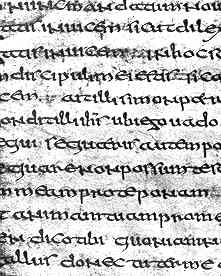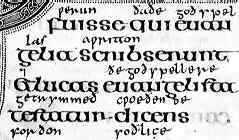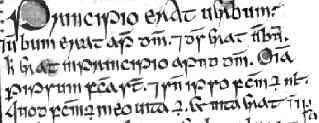




If you are looking at this page without frames, there is more information about medieval writing to be found by going to the home page (framed) or the site map (no frames).
| Post-Roman Scripts | ||||
| While the monasteries of Europe were reintroducing Christianity, and producing fine and prestigious religious books in uncial and half uncial scripts derived from Rome, a whole series of more localised scripts was being developed across western Europe. They were all minuscule scripts which owed much to New Roman cursive. However, the cursive style had been made more formal and calligraphic, developing into a variety of elaborate styles. | ||||
| In older paleography books, and among some more conservative recent authors, these have been called the National Hands. The term is largely inappropriate as it implies a series of discrete categories kept separate by concepts of nationhood. In fact, they represent a very fluid, interacting series of styles, defined by their most distinctive variants, in an unstable political climate. They comprise insular minuscule (Ireland and Anglo-Saxon England), Merovingian (France), Germanic (Germany), Visigothic (Christian Spain), Lombardic (northern Italy) and a related type called Beneventan (southern Italy and Dalmatia). | ||||
| This map shows the National Hands and other related specialised scripts in the 7th-8th centuries. | ||||
| The most long lived of the National Hands was insular minuscule. This can be regarded not so much as a script but as a whole family of scripts ranging from formal book hands with carefully separated letters, sometimes called set minuscule, through various grades of more speedily written styles to a cursive minuscule. (See Backhouse, Turner and Webster 1984, also Brown 1991, also Byrne 1979, also Henderson 1987) | ||||
 |
Insular minuscule in an 11th century work on the Marvels of the East (British Library, Cotton Tinerius B V), by permission of the British Library. | |||
| The above example represents a sample from a bilingual Latin-English work in which insular minuscule was used for the Old English version of the text. | ||||
| The history of insular minuscule is tied up with the history of Christianity in Britain, which was reintroduced after the Roman era from two directions. The conversion of Ireland in the 5th century introduced Latin literacy and the development of a distinctive script. This tradition was brought to Lindisfarne from Iona by Irish missionaries in the 7th century. The mission of St Augustine to Kent in the late 6th century provided a more direct route for the formal book hands of Rome. The earliest manuscripts from Ireland were produced in their own local script. However until around the 8th century, books from Canterbury and other southern centres were transcribed in uncial or half uncial script. |
 |
|||
| An early version of insular scipt from Ireland, in this case a half uncial form, from a 7th century fragmentary gospel in Trinity College, Dublin. (From Thompson 1912.) | ||||
| The interaction between these styles in centres such as Wearmouth and Jarrow produced a script style which spread throughout Anglo-Saxon Britain and beyond. It was also found in Brittany. The foundation of various monasteries in Europe by Irish and Anglo-Saxon missionaries established important scriptoria in Europe which also produced insular minuscule. | ||||
| Columbia University Library displays an image of a text page in insular minuscule from a 9th century German manuscript (Isidore, Synonyma - Plimpton MS 127 frag., f.4) | ||||
| An early formal book hand produced in Britain and Ireland in the insular tradition was a form of half uncial, and is therefore called insular half uncial. It had developed certain peculiarities, including curved wedge shaped ascenders to letters and it utilised some capitalised letter forms derived from uncial (D,N,R,S). This script is also known as insular majuscule and possibly represents an early and formal variety of the insular script derived from Gaulish contacts. It is known from such famous works as the Book of Kells and the Lindisfarne Gospels. | ||||
 |
A sample of script from the Lindisfarne Gospels (British Library, Cotton Nero D IV, f.5), by permission of the British Library. | |||
| In this example, the main text is late 7th century and wriiten in insular half uncial. The Old English gloss between the lines is 10th century and is in a pointed insular minuscule. | ||||
| You can look at a text page from the Book of Kells on the web. The British Library shows a page of script from the Lindisfarne Gospels, as well as a number of other pages.. | ||||
| Insular minuscule was characterised by a rather extravagant curling appearance, exaggerated in letters like e, g, r and s. It was heavily ligatured and made extensive use of abbreviations. It could thus be written quickly, but retained a calligraphic style. | ||||
| Insular minuscule was retained in England until the 10th century for Latin books and vernacular charters, when it was replaced for Latin usage by Caroline minuscule. However, it continued to be used for books or documents written in Old English. Bilingual words used Caroline minuscule, or later protogothic, for the Latin text and insular minuscule for the English, so that scribes must have been competent in both. This later insular minuscule tended towards the neat rounded appearance of Caroline minuscule, while retaining certain distinctive letter forms. In English, several new letters were introduced to the alphabet, borrowed from Runic letters. There were two characters for th and one for w. | ||||
 |
||||
| A late form of insular minuscule in the English version of a bilingual charter of Henry I from 1123 (British Library, Campbell charters xxi 6), by permission of the British Library. | ||||
| Insular minuscule was not replaced in Ireland until the 13th century when the Gothic script was already well established in other regions. However, Irish scribes rediscovered insular minuscule in the 14th century, along with a renewed nationalistic pride, and it was revived. The craft of writing insular minuscule in Ireland survived into modern times. | ||||
 |
An example of Irish insular minuscule from the 12th century in the Gospels of Maelbrigte (British Library, Harley 1802, f.128), by permission of the British Library. | |||
| This example shows the use of a great deal of abbreviation and some extravagant letter forms. | ||||
| Insular minuscule can be written in a variety of styles and degrees of informality. It may therefore be described as rounded, square or pointed, set or cursive, and divided into grades. It is the most elegant of all the scripts, well, in my personal opinion anyway. Although it may be hard to read at first, and despite certain calligraphic extravagances, its internal consistency and distinctive letter forms mean the code is not too hard to crack. | ||||
|
|
||||
|
|
||||
|
|
||||
|
If you are looking at this page without frames, there is more information about medieval writing to be found by going to the home page (framed) or the site map (no frames). |
||||